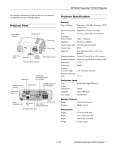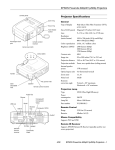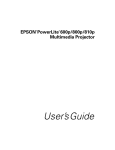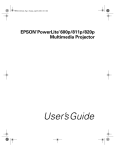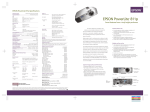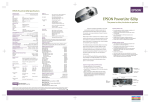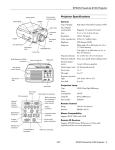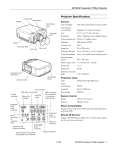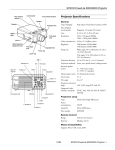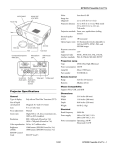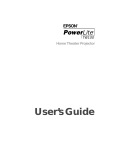Download Epson ELP-600 Specifications
Transcript
EPSON PowerLite 600p/800p/810p Projectors control panel Projector Specifications zoom ring General Type of display focus ring Size of LCD panels Diagonal: 0.9 inches (22.9 mm) foot release button Lens F=1.74 to 2.06, f=28.3 to 37.98 mm Resolution (native format) Kensington lock port Poly-silicon Thin Film Transistor(TFT), active matrix remote control receiver 1024 × 768 pixels (800p and 810p) 800 × 600 (600p) Color reproduction 24 bit, 16.7 million colors lamp cover latch status lights Brightness 2000 lumens (ANSI) (810p) 1500 lumens (ANSI) (800p) 1700 lumens (ANSI) (600p) Contrast ratio 400 : 1 Image size 30 to 300 inches Projection distance 2.85 to 40.7 feet (0.87 to 12.4 meters) Projection methods Front, rear, upside-down (ceiling mount) Internal speaker system 5 W monaural Optical aspect ratio 4 : 3 (horizontal : vertical) handle 1 : 135 Noise level 38 dB Keystone correction angle A/C power inlet speaker back adjustable foot Zoom ratio remote control receiver Vertical: ± 30° maximum Horizontal: ± 10° maximum Projection Lamp Audio Out Mouse Computer2/ Component Video Serial USB out Monitor Out USB in Computer1 (DVI) Type UHE (Ultra High Efficiency) Power consumption 200 W Lamp life About 1500 hours Part number ELPLP15 Remote Control Audio1 Range 32.8 feet (10 meters) Batteries Alkaline AA (2) Mouse Compatibility Supports PS/2 and USB S-Video optional remote receiver Audio2 Remote IR Receiver Supports EPSON Remote IR Receiver (typically used for rear screen projection) Composite Video 8/01 EPSON PowerLite 600p/800p/810p Projectors - 1 EPSON PowerLite 600p/800p/810p Projectors Dimensions . Resolution DVI support 57 640 × 400 supported 70 640 × 350 supported 60 640 × 480 supported VESA72 72 640 × 480 supported VESA75 75 640 × 480 supported VESA85 85 640 × 480 supported VGA120 120 640 × 480 SVGA56 56 800 × 600 supported SVGA60 60 800 × 600 supported SVGA72 72 800 × 600 supported SVGA75 75 800 × 600 supported SVGA85 85 800 × 600 supported SVGA120 120 800 × 600 Height 4.1 inches (104 mm) Mode Width 13.7 inches (348 mm) PC98 VGAEGA VGA60 Depth 10.8 inches (274 mm) Weight 9.3 lb (4.2 kg) Electrical Rated frequency 50 to 60 Hz Power supply 100 to 120 VAC, 3.1 A 200 to 240 VAC, 1.5 A Power consumption Operating: 280 W Standby: 5.5 W XGA43i 43 1024 × 7681 Operating: 41 to 95 °F (5 to 35 °C), XGA60 60 1024 × 7681 supported XGA70 70 1024 × 7681 supported Storage: 14 to 140 °F (–10 to 60 °C), XGA75 75 1024 × 7681 supported Operating: 20 to 80% RH, non-condensing XGA85 85 1024 × 7681 supported XGA120 120 1024 × 7681 SXGA1—70 70 1152 × 8642 supported SXGA1—75 75 1152 × 8642 supported SXGA1—85 85 1152 × 8642 supported SXGA1—100 100 1152 × 8642 Environmental Temperature Humidity Refresh rate (Hz) Storage: 10 to 90% RH, non-condensing Safety FCC Part 15B Class B UL1950 Rev. 3 SXGA2—60 60 1280 × 9602 supported SXGA2—75 75 1280 × 9602 supported Canada DOC ICES003 Class B CSA C22.2 No. 950 Rev. 2 SXGA2—85 85 1280 × 9602 SXGA3—43i 43 1280 × 10242 CE Marking Directive 89/336/EEC, 73/23/EEC EN 55022, EN 55024, EN 60950 United States Compatible Video Formats The projector supports the following video standards: NTSC, HDTV, PAL, and SECAM, as well as the monitor display formats listed below. To project images output from a computer, the computer’s video card must be set at a refresh rate (vertical frequency) that’s compatible with the projector; see the following table for compatible formats. Some images are automatically resized to display in the projector’s native format. The frequencies of some computers may not allow images to display correctly; see your computer’s documentation for details. 2 - EPSON PowerLite 600p/800p/810p Projectors 8/01 SXGA3—60 60 1280 × 10242 supported SXGA3—75 75 1280 × 10242 supported SXGA3—85 85 1280 × 10242 SXGA+60 60 1400 × 10502 supported SXGA+75 75 1400 × 10502 supported SXGA+85 85 1400 × 10502 supported UXGA48i 48 1600 × 12002,3 UXGA60 60 1600 × 12002,3 UXGA65 65 1600 × 12002,3 UXGA70 70 1600 × 12002,3 UXGA75 75 1600 × 12002,3 UXGA80 80 1600 × 12002,3 UXGA85 85 1600 × 12002,3 iMAC VGA 117 640 × 480 iMAC SVGA 95 800 × 600 iMAC XGA 75 1024 × 7681 supported MAC II 13 67 640 × 480 supported MAC16 75 832 × 624 supported MAC19 75 1024 × 7681 supported MAC21 75 1152 × 8702 supported TV525i 60 2 TV625i 50 2 SDTV525p 60 2 supported HDTV750p 60 2 supported HDTV1125i 60 2 EPSON PowerLite 600p/800p/810p Projectors Refresh rate (Hz) Mode Resolution NTSC 60 2 NTSC4.43 60 2 PAL 50 2 M-PAL 60 2 N-PAL 50 2 PAL60 60 2 SECAM 50 2 DVI support 1 The image is resized so that it displays using one of the projector’s native formats (PowerLite 600p only). 2 The image is resized so that it displays using one of the projector’s native formats. 3 Not supported on the PowerLite 600p Positioning the Projector Follow these guidelines to get the best results when projecting: ❏ Place the projector on a sturdy, level surface, between 2.85 and 41 feet from the screen. ❏ Make sure there is plenty of space for ventilation around and under the projector. ❏ Make sure the projector is within 10 feet of a grounded electrical outlet or extension cord and within 5 feet of the image source. ❏ Face the projector squarely toward the screen. Note: It’s easier to position the projector when the screen is directly in front of the room. However, if you need to place it offcenter, you can use the keystone correction feature to maintain a square image. Computer Video Port Pin Assignments The Computer 2/Component Video port is a female video RGB, 15-pin micro-D-style connector. Here are the pin assignments: Pin # Computer 2/Component Video port (analog) 1 Red video 2 Green video 3 Blue video 4 GND 5 GND 6 Red video GND 7 Green video GND 8 Blue video GND 9 Reserved 10 Synchronous GND 11 GND 12 SDA 13 Horizontal sync/composite sync 14 Vertical sync 15 SCL If you place the projector below the level of the screen, you’ll have to tilt it up by extending the foot as shown. Tilting the projector upward causes the image to lose its square shape, but you can correct the distortion by pressing the Keystone button as described on page 6. ideal height If you place the projector level with the bottom of the screen, the image will be square and you won’t have to adjust it. If you place the projector higher than the bottom of the screen, the image will still be square, but you won’t be able to fill the whole screen with the image. ELP Link Lite If you want to be able to control the projector’s settings from a computer, you can install the ELP Link Lite program. You can download this program, plus its User’s Guide, from EPSON’s web site at support.epson.com. You’ll also need a serial or USB cable to connect the projector to the computer. 8/01 EPSON PowerLite 600p/800p/810p Projectors - 3 EPSON PowerLite 600p/800p/810p Projectors Image Size and Projection Distance The projector can be installed for four different viewing setups: front projection, ceiling mounting, rear projection onto a semi-transparent screen, or rear/ceiling projection, as shown: Use the tables below to estimate how far to place the projector from the screen. Since the size of the image can be changed by rotating the zoom ring, a range of distance is given for each screen size. Note that if you tilt the projector upward by extending the foot or use electronic keystone correction, your image size may vary. front projection ceiling mounting Diagonal screen size Distance 30 inches 2.9 to 3.9 feet (0.87 to 1.20 meters) 60 inches 5.9 to 8 feet (1.80 to 2.45 meters) 100 inches 9.9 to 13.6 feet (3.02 to 4.13 meters) 200 inches 20 to 27.2 feet (6.10 to 8.30 meters) 300 inches 30.1 to 40.9 feet (9.17 to 12.48 meters) Displaying an Image rear projection Once the projector is connected to your computer or video source and plugged in, press the red Power button on top of the projector to turn it on. The power light flashes green as the projector warms up, and the projection lamp comes on in about 30 seconds. The power light stays green, and you may see a blue screen with the message No Signal displayed. This is normal. rear/ceiling projection Do one of the following: To project from overhead, you’ll need to select Ceiling in the projector’s Advanced menu. To project from the rear, select Rear Proj. ❏ Turn on or restart your computer. In a few moments, you should see your computer display projected. If you’re ceiling-mounting the projector and you place it above screen level, you’ll have to tilt it down to position the image on-screen. This causes the image to lose its square shape. You can then correct the distortion by using the V Keystone function in the projector’s menu system or by using the Keystone buttons on the projector’s control panel. If you see a New Hardware Wizard message saying that it has found a plug-and-play monitor, click Cancel. If you see a New Hardware Wizard message about USB audio, click Next and follow the instructions on the screen (Windows only). ❏ If you’re projecting a video, press the Play button on your video source. If a projected image fails to appear, see the next section for help. 4 - EPSON PowerLite 600p/800p/810p Projectors 8/01 EPSON PowerLite 600p/800p/810p Projectors What To Do If You See a Blank Screen If the Arrange option isn’t available, you may need to select one of the Simulscan resolution settings: If you see a blank screen or a blue screen with the message No Signal after turning on your computer or video source, do one of the following: 1. Click the Monitor icon. Click here ❏ Make sure the cables are connected correctly, as described in the User’s Guide. ❏ Make sure the power light is green and not flashing and the lens cover is off. ❏ Try restarting your computer. ❏ If you’ve connected more than one computer and/or video source, you may need to press the Computer/YCbCr or Video button on top of the projector to select the correct source. Allow a few seconds for the projector to sync up after pressing the button. Select a Simulscan resolution 2. Select a Simulscan resolution as shown. Allow a few seconds for the projector to sync up after making the selection. If you’re using a PowerBook: You may need to set up your system to display on the projector screen as well as the LCD screen. Follow these steps: If you’re using a PC laptop: ❏ Hold down the the Fn key and press the function key that lets you display on an external monitor. It’s often labelled with an icon such as but it may also be labelled CRT/ LCD. Allow a few seconds for the projector to sync up after pressing it. 1. From the Apple menu, select Control Panels, then click Monitors or Monitors and Sound. 2. Click the Arrange icon and drag one monitor icon on top of the other. Click here On most systems, the or CRT/LCD key lets you toggle between the LCD screen and the projector, or display on both at the same time. Check your laptop’s manual or online help for details. ❏ Depending on your computer’s video card, you might need to use the Display utility in the Control Panel to make sure that both the LCD screen and external monitor port are enabled. See your computer’s documentation or online help for details. Drag one monitor icon on top of the other Resizing the Image Some computer images need to be resized to display in the projector’s native format. If only part of your computer image is displayed, you can correct it with the Resize button. ❏ Press the Resize button on the control panel or remote control. The screen image is automatically compressed. ❏ Continue pressing the Resize button to pan around the screen in the original resolution. If you’re projecting from video equipment, pressing the Resize button switches the aspect ratio between 4:3 and 16:9. If you’ve zoomed in on your image (using the E-Zoom button on the remote), you can press the Resize button to restore the original display size. 8/01 EPSON PowerLite 600p/800p/810p Projectors - 5 EPSON PowerLite 600p/800p/810p Projectors Adjusting the Image Shape Projector Status Lights If the projected image isn’t square or has a “keystone” shape, do one or more of the following: The lights on top of the projector indicate the projector’s operating status. ❏ If your image looks like or , you’ve placed the projector off to one side of the screen, at an angle. Move it directly in front of the center of the screen, facing the screen squarely. If you still can’t get a square image, press the left or right Keystone button on the projector’s control panel. power light lamp light temperature light ❏ If your image looks like or , press the top or bottom Keystone button to correct the shape of the image. After correction, your image will be slightly smaller. You can also perform electronic keystone correction using the projector’s Setting menu. Switching Between Picture Sources If your projector is connected to more than one computer and/or video source, you can use the buttons on the control panel (or remote control) to switch between the different sources. On the control panel, press the Computer/YCbCr button to switch between computer sources and component video. Press the Video button to switch between standard (composite) video and S-Video sources. Light On the remote control: ❏ Press the Comp2/YCbCr button to select a computer or component video source connected to the Computer 2/ Component Video port on the projector. ❏ Press the Comp1 button to select a computer connected to the DVI Computer 1 port on the projector. ❏ Press the Video button to select a standard composite video source. ❏ Press the S-Video button to select an S-Video source. After you select a source, the screen goes dark for a moment before the image appears. 6 - EPSON PowerLite 600p/800p/810p Projectors 8/01 Status Description and action Does not come on Make sure the power cord is securely connected at both the power outlet and projector. Green The projector is operating normally. Flashing green The projector is warming up. Wait for the image to appear. Orange The projector is in sleep mode. You can unplug it to turn it off, or press the Power button to turn it on. Flashing orange The projector is cooling down. Wait for the light to stop flashing before unplugging the projector or turning it back on. Flashing red Power is cut off because of an internal problem. Disconnect the power cord and contact EPSON for help. Red The lamp is burned out and must be replaced. Flashing orange The lamp is almost burned out. This is a good time to replace it. Flashing red There is a problem with the lamp, power supply, fan, or circuit. If necessary, replace the lamp. EPSON PowerLite 600p/800p/810p Projectors Light Status Description and action Button Function Flashing orange The projector is too hot. Make sure the temperature surrounding the projector does not exceed 95 °F and there is plenty of space around and under the projector for ventilation. Clean the air filter if necessary. Sync + Sync – Red The projector is overheating, which turns off the lamp automatically. Let it cool for a few minutes, then turn it back on. Make sure there is plenty of space around and under the projector for ventilation. If it continues to overheat, you may need to change the air filter. Use after tilting the projector (extending its foot) to square up the image. Corrects up to a ±30° tilt. Allows selection of a menu or menu options if the menu screen is displayed. When used with the Shift button, synchronizes the computer’s graphic signal. Use these buttons to adjust a fuzzy-looking image that contains a lot of fine detail. Tracking – Tracking + Corrects horizontal keystone distortion, which occurs when the projector is not directly in front of the screen. Allows selection of menu options if the menu screen is displayed. When used with the Shift button, matches the projector’s internal clock to computer graphic signals. Use these buttons to eliminate vertical stripes or bands from an image that contains a lot of fine detail. Flashing red There is a problem with the cooling fan or temperature sensor. Turn off the projector and unplug it. Contact EPSON for help. Enter, Auto Shift Press with the Sync or Tracking buttons to change their function from Keystone control to Sync or Tracking. Resize Resizes non-standard computer video formats so they appear correctly on screen. Switches the aspect ratio between 4:3 and 16:9 when video images are being projected. A/V Mute Turns off the audio and video. (In the menu system, you can set whether the screen appears black or blue, or displays a user logo.) Volume Adjusts the volume. Using the Control Panel Power Help Computer/YCbCr Video Source Menu Esc Sync+ Tracking - Auto Tracking + Using the Remote Control Keystone Shift Selects a menu option or the next menu/help screen. Pressing Enter when no menu or help screen is displayed optimizes the computer image. Sync- Resize A/V Mute The remote control uses a line-of-sight infrared signal. It lets you access the projector’s features from anywhere in the room—up to 32 feet away. (This distance may be shorter if the remote control batteries are low.) If you have connected the mouse cable, you can also use the remote control as a wireless mouse. Volume The following table summarizes the functions on the control panel. The projector may not respond to remote control commands in these conditions: ❏ The remote control is not turned on (using the switch on its side) Button Function Power Starts or stops projection. Help Displays the online help menu. Computer/ YCbCr Switches between the source connected to the Computer 1 port and the Computer 2/Component Video port. ❏ Batteries are weak Video Switches between composite video and S-Video. ❏ A fluorescent light is shining into the infrared receiver Menu Displays or hides the menu screen. Esc Stops the current function. Pressing Esc while viewing a menu or the online help displays the previous screen or menu. ❏ A strong light source (such as direct sunlight) shines into the infrared receiver ❏ You are too far away or not within 30° to the left or right of the front or rear sensor or 15° above or below ❏ Ambient light is too bright ❏ Other equipment emitting infrared energy is present (such as a radiant room heater) 8/01 EPSON PowerLite 600p/800p/810p Projectors - 7 EPSON PowerLite 600p/800p/810p Projectors The remote control buttons are shown in the following illustrations. This table summarizes the functions on the remote control. signal output Freeze Special effects buttons (1-3) Menu Comp1 Video Power Starts or stops the projector. R/C on/off Turns the remote control on or off. Freeze Previous slide Next slide Keeps the current computer or video image on the screen. A/V Mute Turns off the audio and video, displaying the black, blue, or user logo background. Previous/Next slide button The up arrow displays the previous slide; the down arrow displays the next slide. E-Zoom Changes the image size up to 4×. Pressing the right side of the button enlarges the image, pressing the left side reduces the image. To display a portion of an enlarged image which is outside the display area, press the Enter button and scroll the image to the desired location. Effects buttons Displays special highlighting effects on the screen. Enter (pointer button) Use the Enter button to navigate the menus or use the remote as a mouse pointer when the projector is connected to a computer with the mouse or USB cable. Esc Stops the current function. Pressing Esc while viewing a menu or the online help displays the previous screen or menu. When the image source is a computer, the Esc button acts as a mouse right-click. Left mouse button Works like the left button on a mouse when the projector is connected to a computer with the mouse or USB cable. Menu Displays or hides the menu. Help Displays the online help menu. Comp1 Switches to the Computer 1 (DVI) image. Comp2/YCbCr Switches to the Computer 2 or component video source. Comp2/YCbCr Video Switches to the composite video source. S-Video S-Video Switches to the S-Video source. Auto Optimizes the computer image. Resize Resizes SXGA and other video formats so they appear correctly on the screen. Switches the aspect ratio between 4:3 and 16:9 when video images are being projected. P in P Displays a video or S-Video image in a subscreen on the main display. Use the Enter button to reposition the Picture in Picture (P in P) screen, or the E-Zoom button to enlarge or reduce the image. Changes made to the P in P screen location and size are automatically carried over to the next P in P session. On/off switch Enter (pointer) button Left mouse button Function Power A/V Mute E-Zoom Button Esc button Help Auto Resize P in P Preset Volume 8 - EPSON PowerLite 600p/800p/810p Projectors 8/01 EPSON PowerLite 600p/800p/810p Projectors Button Function Preset Saves and recalls up to five different session settings (resolution, tracking, sync signal, and position). To save the current session settings, press the Preset button and it will be assigned the next available number, 1 through 5. To recall a setting, press the Preset button a second time and move to the desired session number. To overwrite a saved setting, move to the setting you want to replace and press Enter. When the confirmation message displays, choose Yes and press Enter. Volume Cleaning the Projector Case Before you clean the projector case, turn off the projector and unplug the power cord. ❏ To remove dirt or dust, wipe the case with a soft, dry, lintfree cloth. ❏ To remove stubborn dirt or stains, moisten a soft cloth with water and a neutral detergent. Then wipe the case. ❏ Do not use wax, alcohol, benzene, thinner, or other chemical detergents. These can damage the case. Adjusts the volume. The three special effects buttons have the following functions. Button Function 1 Changes the mouse cursor to a pointer or arrow. 2 Spotlights a section of the screen. 3 Lets you place a vertical or horizontal bar on the screen to highlight a part of your image. Cleaning or Replacing the Air Filter Clean the air filter at the bottom of the projector after every 100 hours of use. If it is not cleaned periodically, it can become clogged with dust, preventing proper ventilation. This can cause overheating and damage the projector. Follow these steps: 1. Turn off the projector, allow it to cool down, and unplug the power cord. Note: You can use the projector’s Effect menu to modify the highlighting effects for each of the numbered buttons. 2. Turn the projector on its side so that the handle is on top and you can access the filter easily. 3. To clean the filter, EPSON recommends using a small vacuum cleaner designed for computers and other office equipment. If you don’t have one, gently clean the filter using a very soft brush (such as an artist’s camel-hair brush). Cleaning the Lens Warning: Before you clean any part of the projector, turn it off and unplug the power cord. Never open any cover on the projector, except the lamp and filter covers. Dangerous electrical voltages in the projector can injure you severely. Do not try to service this product yourself, except as specifically explained in this Product Information Guide. Refer all other servicing to qualified service personnel. Clean the lens whenever you notice dirt or dust on the surface. ❏ Use a canister of compressed air to remove dust. ❏ To remove dirt or smears on the lens, use lens cleaning paper. If necessary, moisten a soft cloth with an alcoholbased cleaner and gently wipe the lens surface. If the dirt is difficult to remove or if the filter is torn, replace it. Contact your dealer or call EPSON at (800) 873-7766 in the United States and Canada to obtain a new one. Note: When you get a replacement lamp for your projector, a new air filter is included. You should replace the filter when you replace the lamp. 8/01 EPSON PowerLite 600p/800p/810p Projectors - 9 EPSON PowerLite 600p/800p/810p Projectors 3. Use a screwdriver to slide the latch and pop open the lamp cover. Then lift it up and remove it. 4. If you need to replace the filter, make sure the projector is on its side as shown (not turned upside down) to prevent dust from falling inside. Then press the arrow tab to remove the filter. arrow tab 4. Use a screwdriver to loosen the two silver screws holding the lamp in place. (You can’t remove these screws.) 5. To install the new filter, first insert the tabs, then press on the latch until it clicks in place. Replacing the Lamp The projection lamp typically lasts for about 1500 hours of use. It is time to replace the lamp when: 5. Grasp the lamp as shown, and pull the lamp straight out. ❏ The projection image gets darker or starts to deteriorate. ❏ The lamp warning light is red or flashing red. ❏ The message LAMP REPLACE appears on the screen when the projector lamp comes on (after about 1400 hours of use). To maintain projector brightness and image quality, replace the lamp as soon as possible. Note: You can check to see how many hours the lamp has been used through the About menu. Contact your dealer or call EPSON at (800) 873-7766 in the United States and Canada for a replacement lamp. Request part number V13H010L15. Caution: Do not touch the glass portion of the lamp assembly. 6. Fully insert the new lamp. 7. Once the lamp is fully inserted, tighten its screws. Warning: Be extremely careful when removing the lamp module. In the unlikely event that the bulb has ruptured, small glass fragments may be present and should be removed with caution. If your projector is mounted on the ceiling, you should unmount it before accessing the lamp compartment. This will make it easier for you to replace the lamp and minimize the chance of any small glass fragments dropping from the projector. 8. To replace the lamp cover, insert the tabs and then snap the cover into place. (The projector won’t come on if the lamp cover is loose.) Follow these steps to replace the lamp: 1. Turn off the projector and unplug the power cord. 2. Allow the projector to cool down for at least half an hour (if it has been on). 10 - EPSON PowerLite 600p/800p/810p Projectors 8/01 EPSON PowerLite 600p/800p/810p Projectors Resetting the Lamp Timer Optional Accessories After you install a new lamp, you need to reset the timer so the projector can keep track of how many hours it has been used. Follow these steps: 1. Press the Menu button on the control panel or the remote control. You see the main menu. 2. Use the Sync– button (control panel) or the (remote control) to highlight About. button You see the lamp usage hours and other settings. 3. Press to select Reset Lamp Timer. Press again. 4. When you see the confirmation message, select Yes, then press . 5. When you’re finished, press Esc or Menu. ESC/VP21 Commands When the projector is in a command ready state, it returns the : code. When command processing is complete, the projector also returns a : code. If command processing terminates with an error, an error message is output and then the : code is sent. Item Command Power ON/ OFF ON PWR ON OFF PWR OFF Signal selection Computer1 (Analog-RGB) SOURCE 11 Computer1 (Digital-RGB) SOURCE 12 Computer1 (RGB-Video) SOURCE 13 Computer2/Component Video (Analog-RGB) SOURCE 21 Computer2/Component Video (RGB-Video) SOURCE 22 Computer2/Component Video (YCbCr) SOURCE 23 Computer2/Component Video (YPbPr) SOURCE 24 Video SOURCE 41 S-Video SOURCE 42 A/V Mute ON/OFF ON MUTE ON OFF MUTE OFF A/V Mute selection Black Product Product number Replacement lamp and air filter V13H010L15 Customized carrying cases: Samsonite® wheeled soft case ATA molded hard shell case ATA shipping case Soft shoulder bag ELPKS35 ELPKS40 ELPKS41 ELPKS13 Ceiling mount ELPMB36 Kensington security lock ELPSL01 Portable projection screens: 50-inch 60-inch 80-inch ELPSC06 ELPSC07 ELPSC08 Wireless microphone and two satellite speakers ELPCVS1 Auxiliary audio system ELPPAS1 Remote control receiver (plugs into projector to extend range of remote control) ELPST02 Remote control receiver kit (includes standard receiver and clip-on receiver for attachment directly to remote control) ELPST04 Macintosh adapter set (includes monitor adapter and desktop adapter) ELPAP01 Component video cable (VGA to component video) ELPKC19 Digital video cables: DVI to DVI, 10 feet (3 meters) DVI to DFP, 10 feet (3 meters) DVI to analog video, 10 feet (3 meters) ELPKC20 ELPKC21 V12H005C25 You can purchase these accessories from your dealer or by calling EPSON at (800) 873-7766; or visit the EPSON StoreSM at www.epson.com (U.S. sales only). In Canada, please call (800) 873-7766 for dealer referral. Related Documentation CPD-12788 EPSON PowerLite 600p/800p/810p User’s Guide CPD-12789 EPSON PowerLite 600p/800p/810p Quick Setup Poster MSEL 00 Service Manual TM-800/810, TM-600 Blue MSEL 01 Parts Price Lists PL-800/810, PL-600 User’s Logo MSEL 02 8/01 EPSON PowerLite 600p/800p/810p Projectors - 11 EPSON PowerLite 600p/800p/810p Projectors 12 - EPSON PowerLite 600p/800p/810p Projectors 8/01












